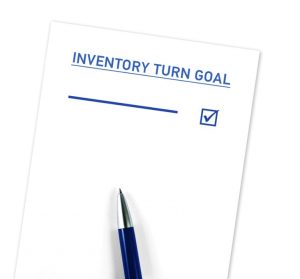How to Establish Inventory Goals That Work
From establishing effective goals for finished goods, raw materials, and work in progress with this comprehensive guide. Once you’ve organized and tracked your supply using inventory management systems, it’s crucial to set measurable goals to ensure optimal turnover rates, maintain safety stock levels, and achieve customer satisfaction. These goals will help you meet demand forecasts, improve cash flow, and manage inventory costs, which will positively impact your balance sheet.
Set and achieve your goals by aligning your inventory planners with your business objectives. This will put you on the path to success. Additionally, it will help you maintain a steady cash flow and meet customer demand.
Jeff Sheets, who has provided dealership consulting as a member of Bob Clements International, explains how to do just that in this guide.
This guide will show you how to:
- Set smart goals
- Define min/max levels
- Leverage supply chain data
- Establish turnover rate targets
- Use key metrics to measure success
- And much more!
My inventory is organized and counted. What now?
Once you’ve accurately counted and organized your inventory, it’s essential to set inventory goals to make sure it never ends up in a poor state again.
With the help of Bob Clements International, we have put together an explanation on how to do just that in this guide.
Put your Parts Manager in charge

Keeping tabs on your inventory can be very time-consuming, and due to priorities such as sales and management, it’s not something a dealership owner can commit to.
Investing in a Parts Manager helps boost your process and saves your dealership time.
FAQ: What are the responsibilities of a parts manager?
The main roles of a parts manager typically include:
Inventory management: Maintaining accurate records of all parts inventory, including ordering and receiving new parts, monitoring stock levels, and disposing of obsolete or damaged parts.
Sales and customer service: Parts managers often interact with customers to help identify and locate the parts they need. They may also work with sales teams to generate revenue and build customer relationships.
Team management: Sometimes parts managers may be responsible for leading and supervising a team of employees who work in the parts department. This includes scheduling, training, and performance management.
Cost management: Managing the parts department’s budget and ensuring that the cost of inventory and other expenses are within the organization’s financial goals.
Safety and compliance: Parts managers are also responsible for ensuring that the department adheres to all safety and compliance regulations, including hazardous materials handling and disposal.
Check out our Parts managers checklist for more information.
TIP: The key to proper parts management is to have as few people dealing with your parts as possible. Do not let your service techs handle your parts because they tend to pull items off the shelf without accounting for where they come from, which can lead to major stocking issues.
Getting your Parts Manager to cooperate
Let your Parts Manager be the one to handle the parts for the service techs. It will not only help your inventory levels but result in more billable hours for your techs because they won’t have to leave their area and waste time looking for parts.
TIP: Consider implementing an incentive plan for doing good work as well. For example, if your Parts Manager keeps the inventory 95% accurate over a set period of time, offer them a bonus. This holds them accountable and drives them to keep your quantity levels and parts movement in good order.
Set an inventory turn goal
Sheets says that one of the most commonplace problems is that dealers don’t apply a goal-oriented approach to their inventory management. He suggests that every dealer should at least have an inventory turn goal.
FAQ: What’s an inventory turn goal?
An inventory turn is defined as the number of times inventory is replenished in a year.
It’s calculated by dividing the average inventory level (or current inventory level) by the annual inventory usage (or the annual cost of goods sold).
The purpose of this goal is to keep your items moving constantly and avoid wasting money on something you won’t be able to sell.
Aim high
It’s common for dealers to have an inventory turn of one or two, but Sheets believes you should set four as the goal. If you have an inventory turn goal of four, then only 25% of your inventory should be on your shelf at one time. If your inventory turn is typically two, then you would already have 25% more in your bank account rather than stocking up on your shelf.
It never hurts to shoot high when it comes to inventory goals. However, it is important to choose a turn number that does make sense for your business. One thing to remember – if you decide to shoot higher than four, you may run the risk of running into stock-out problems.
With a turn goal in place, it’s time to look for ways to achieve it – and that starts with inventory Control.
FAQ: What is inventory control?
Inventory control refers to the processes and systems used to manage a company’s inventory levels, optimize stock levels, monitor inventory flow to reduce waste, minimize stock-outs, and ensure that enough inventory is on hand to meet customer demand.
FAQ: Why is inventory control important?
Effective inventory control is crucial for businesses to optimize their inventory levels, improve operational efficiency, reduce waste, and ensure customer satisfaction. It helps to minimize the risk of stock-outs or overstocking, which can lead to lost sales, increased carrying costs, and reduced profitability.
FAQ: How do I establish inventory controls?
Once you’ve accurately counted and organized your inventory, it’s essential to set inventory goals to make sure it never ends up in a poor state again.
Read next: Best Practices for Effective Inventory Counting
Set min/max levels

Setting up minimum and maximum ordering levels for your parts is going to provide you with the most headway in maintaining inventory control.
By setting these levels, you’re putting parameters on your parts, so that you don’t go too far over or under when ordering a certain item. Therefore, it’s extremely important to go through your sales history from the previous year and set seasonal levels that prevent you from becoming too overstocked or understocked.
Account for slower months
To prevent becoming overstocked during the slow season, you need to reduce the number of items you order. So, once August hits, you should start working those stocking quantities down. This way you’ll have the ability to buy the right parts at the right time and take advantage of manufacturer discounts.
TIP: Sheets recommends that you should have no more than 30% of your peak inventory stocked during the slow season.
Reap the benefits of the busy season
With an industry-specific dealer management software keeping up with inventory demand during your busy season is easier than ever! With its tracking capabilities you can predict the levels for each part. When the levels become low, the software will automatically request an order recommendation based on the levels you set.
Similarly to taking inventory counts, you need to analyze your min/max settings on a continual basis. If you don’t analyze your sales history and change your levels on at least a yearly basis, you run the risk of overstocking on parts that may not sell well a couple of years down the road.
Check out our Vlog Series: Improve Efficiency at Your Dealership This Busy Season!
Plan for the future

Now that you have your guidelines set, it’s time to plan for the future to make sure your inventory is always in top condition.
According to Jeff Sheets, many dealers are reluctant to plan ahead, which means that their inventory is never quite as lean and organized as it should be.
If you have put all the extra work into counting, getting rid of dead items, organizing, working with your Parts Manager as well as setting turn goals and min/max levels, then you must keep moving forward!
TIP: The most important thing in planning for the future is to constantly check the past.
Know your history
Start planning for the future by analyzing your sales history and seasonal trends. This is where having industry-specific dealer management software can be vital – since it allows you to run reports on every aspect of your inventory control, including your sales history.
Even if you’ve been in the business for 20 years and think you know the trends like the back of your hand, you’d be surprised how much insight you can gain from automated reports.
Look to your customers
Every time a customer purchases a product from your store, it’s like they are casting a vote in favor of the items you carry. Therefore, it’s essential to take these “votes” seriously and use them as a guideline for stocking your inventory, rather than relying on guesswork. Additionally, it’s crucial not to overlook the significance of lost sales, an area where many businesses struggle due to a lack of employee effort in recording them.
Making an effort to track lost sales actively can help you identify popular products that you don’t carry. The last thing you want to do is lose customers to your competitors because you don’t stock what they need.
Read Next: 3 Tips for Communicating More Effectively with Customers About Inventory Issues
Plan just a few months ahead
Instead of planning for an entire year all at once, it’s better to plan in smaller increments of 90 or 60 days. Seasonal businesses can experience fluctuations in demand from month to month, and unforeseeable events like a sudden shift in weather can disrupt inventory plans, leading to financial losses. By planning in smaller chunks, you can easily adjust your inventory quantities to accommodate such changes and avoid losing money.
In conclusion, establishing effective inventory goals is vital for any business looking to optimize inventory management, reduce waste, and increase profitability. By setting clear and measurable goals, analyzing inventory data, and implementing appropriate inventory control measures, businesses can ensure that their inventory levels are aligned with customer demand, minimize stockouts and overstocking, and improve overall operational efficiency. With these tips in mind, businesses can take concrete steps to establish inventory goals that work and position themselves for long-term success.
Would you like more details on our Inventory Management module? See it in action right now in our 5-minute video. No need to schedule a call with us – just click on the link and watch



